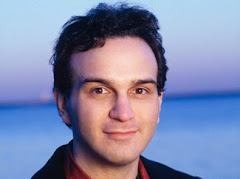It was excellent to welcome violinist Kolja Blacher back to the DFP to play and lead the MPO in a concert of Austro-German classics after his stupendous concert here of Britten, Mozart, Beethoven and Mendelssohn in 2013. This time the concert comprised core repertory items: Mozart's The Marriage of Figaro Overture, Brahms' Violin Concerto and Beethoven's genial Fourth Symphony.
Blacher set off in a sprightly fashion with Mozart's overture to The Marriage of Figaro. After the hushed unison chromatic string passages, this was Mozart played with full vitality and high spirits. The tempo was always moved forward, giving the performance a sense of daring and anticipation, which the precise MPO playing never allowed to falter.
Next, Blacher launched the opening tutti of the Brahms Violin Concerto at a cracking pace, perhaps wanting to set the land speed world record time for the opening first movement of well below 19 minutes. The honour of the fastest speed of the first movement probably belongs to Jascha Heifetz and Fritz Reiner on RCA at 18 minutes and 55 seconds. However, Blacher's overall tempi in concert probably sound faster than Heifetz with phrasing that was a touch too breathless as well.
The Brahms Violin Concerto is probably one of the very toughest in the repertoire to perform, even with the help of an experienced conductor. To play it like Blacher did without the aid of a conductor was very daring indeed. Balance with the orchestra was generally very good, with the exception of the opening solo flourish in sextuplets and quintuplets, where the solo oboe part almost covered the solo violin's elaborate figurations.
Apart from the fast speed and breathless phrasing, Blacher's interpretation was very good in terms of structural integrity. Without much recourse to the odd slowing down and speeding up that is traditionally done, the initial tempo set ran throughout the movement without much obvious change. This lent an excellent coherence to Brahms' massive first movement structure.
Blacher's violin playing was generally very good. His superb intonation and silvery tone was clear and reminiscent of the late Nathan Milstein, obviously aided by the sweet-toned 1730 “Tritton” Stradivarius. His bowing is fluid and unforced (unlike Maxim Vengerov), abetted by a modern French bow made by Nehr.
At times despite very good technique, Blacher's notes were sometimes slightly garbled due to the fast speeds set. As a result, he had to cleverly miss out some of the running notes. In the solo cadenza by Joachim that most violinists favour, his playing also seemed hurried and there were many spots where he could have taken a bit more time to breathe and lavish care over the phrasing.
Tempi concerns faded in the second and third movements, when Blacher adopted more traditional approaches to speed. In one of the classic stories of the 19th-century virtuosi, Pablo de Sarasate refused to play the Brahms Violin Concerto on the basis that the only melody in the slow movement was given to the oboe, rather than the soloist. In the case of this concert, the solo oboe part as played by the superb Simon Emes was a celebration of the smooth liquid tone he brings to the MPO. The second movement was beautifully played, with the exposition and recapitulation sections being intensely hymn-like over Blacher's elaborate figurations over the latter but a not overdone turbulent middle development section.
There was a festive atmosphere in the last movement, which was interpreted in a straightforward manner, without any mannerisms or excess rubato as well. When the third final chords ended a very good performance by Blacher and the MPO, loud and sustained applause broke out from the capacity crowd.
In the second half, we were treated to possibly the best performance of Beethoven's Fourth Symphony that I have ever heard in my life ever since I went to top class classical concerts from 1980 in London and Europe. The Fourth Symphony is sometimes considered a slighter work than many Beethoven symphonies and had been described by Robert Schumann as a “slender Greek maiden” (between the Nordic giants of the Third and Fifth symphonies).
After the slow, mysterious B flat minor introduction to the symphony, the moment the MPO hit the Allegro the sound was just perfect in terms of its size and scale, neither too big and symphonic nor too small and chamber-like. Blacher encouraged a lighter style of playing in the athletically played and ideally paced Allegro vivace (bringing Haydn to mind), with very clear woodwind solo textures from the flute, clarinets and bassoons especially.
The second movement (Adagio) was again ideally paced and had a beautifully singing cantabile quality right throughout the flowing movement, despite the insistent rhythmic heartbeat treads and occasionally martial brass and timpani outburst interjections. The joining phrases across the sections were mainly seamless, barring one unfortunate intonation blip from the horn on a high E flat. A lovely clarinet nocturne with tender ornate string accompaniment ended this very well played movement.
There was earthy energy to the Scherzo-like third movement, but the mood was calmer in the more serene Trio section. The very rapidly played Finale probably exceeded Beethoven's idea of an Allegro ma non troppo. However, Blacher challenged the MPO to be at its virtuosic best, supported by finely controlled playing in the MPO string section with all players declaiming like Berlin Philharmonic concertmasters (which it is rare to witness with the MPO strings). The wind played with equal panache and care for the line, and the furiously quick string passages built great excitement, carrying a joyful arc of sound to the magnificent close that drew long and rapturous applause from the capacity DFP audience.
It makes sense to see Kolja Blacher back at the DFP with the MPO in future seasons, perhaps to play-lead pieces like the Beethoven "Kreuzter" Sonata (as transcribed by Richard Tognetti) and Schönberg's Verklärte Nacht.
Subscribe to:
Post Comments (Atom)


















































No comments:
Post a Comment